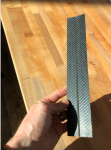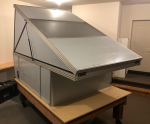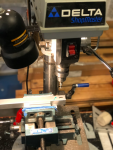This is great insight and something that I will investigate in more detail. What thicknesses did you find were used for the phenolic strips? Also, was the phenolic strip method typically employed with bolted/riveted assemblies, or were structural adhesives ever employed as well? Thank you!Maybe i missed it but i believe there is a key element needed in your design of aluminum to aluminum skin joints. You should add a thermal barrier. These are thin phenolic stips you bond to the aluminum frame before attaching the outer skin. They will eliminate thermal sweating, then i assume you will add insulation between the frames before you skin the inside. This sweating is not the same as condensation from use. I sent almost 10 years running military shelter production and 100% use this design requirement. From small humvee 788 to large ******’s shelters.
You are using an out of date browser. It may not display this or other websites correctly.
You should upgrade or use an alternative browser.
You should upgrade or use an alternative browser.
Hard-sided wedge style pop-up camper shell currently in development/testing in the mountains of Wyoming
- Thread starter WY_CC
- Start date
Thanks for the encouragement! More pics and a substantive update coming later this next week. I've been heads down working on the final layup of all of the framing + panels, experimenting with different hinging / sliding mechanisms, and I just made the cuts for the collapsing sidewalls yesterday. Next steps are bonding the continuous hinges to the sidewalls, curing, bonding the sidewalls to the camper body, curing, then showtime (hopefully). It's been an exciting few weeks since the first post, and I look forward to sharing more details soon...now were talking! been thinking of this concept, makes so much more sense than a tent. any updates or pics on prototype or anything? thx
MuleShoer
Adventurer
the design information is public domain. The attaching method can be riveted or bonded. The barrier is either traditional phenolic or fiberglass.This is great insight and something that I will investigate in more detail. What thicknesses did you find were used for the phenolic strips? Also, was the phenolic strip method typically employed with bolted/riveted assemblies, or were structural adhesives ever employed as well? Thank you!
there are several companies that manufacture these one is in georgia. You could also by a thin sheet and cut them down to your size needed. Just were a respirator
Fiberglass is a good option and potentially easier to source. I'll also look into the phenolics suppliers in GA and elsewhere. Thank you for the tip! I've had great experience in the past contracting with steel suppliers and fabricators in GA, and I'd gladly work with more folks there in the future.the design information is public domain. The attaching method can be riveted or bonded. The barrier is either traditional phenolic or fiberglass.
there are several companies that manufacture these one is in georgia. You could also by a thin sheet and cut them down to your size needed. Just were a respirator
On another fun note regarding advanced materials, I've been experimenting with different hinging methods and came upon carbon fiber kevlar reinforced living hinges. While significantly more expensive than plastic living hinges on a per foot basis, I think they can be selectively utilized to reinforce or replace plastic hinges in high priority areas. I plan to utilize polyolefin hinges along the wall panels and end of the collapsible wedge, and I've been investigating their strengths/weaknesses. There are some real world failures of plastic living hinges where the hinge failed first at one end with a small tear, but the tears show their tendency to want to run. What starts as a small tear can quickly lead to complete failure along the length of the plastic hinge. My first use of the carbon fiber reinforced kevlar hinge will be to attach short lengths to the outside ends of the polyolefin hinge that will see the highest potential load. I've cut the 1' piece shown below into 6" pieces, and I'm incredibly impressed by how strong this stuff appears to be! Although a small detail in the overall project, I thought this would be of interest... Onward!

shade
Well-known member
I wonder if GFC is aware of those hinges.Fiberglass is a good option and potentially easier to source. I'll also look into the phenolics suppliers in GA and elsewhere. Thank you for the tip! I've had great experience in the past contracting with steel suppliers and fabricators in GA, and I'd gladly work with more folks there in the future.
On another fun note regarding advanced materials, I've been experimenting with different hinging methods and came upon carbon fiber kevlar reinforced living hinges. While significantly more expensive than plastic living hinges on a per foot basis, I think they can be selectively utilized to reinforce or replace plastic hinges in high priority areas. I plan to utilize polyolefin hinges along the wall panels and end of the collapsible wedge, and I've been investigating their strengths/weaknesses. There are some real world failures of plastic living hinges where the hinge failed first at one end with a small tear, but the tears show their tendency to want to run. What starts as a small tear can quickly lead to complete failure along the length of the plastic hinge. My first use of the carbon fiber reinforced kevlar hinge will be to attach short lengths to the outside ends of the polyolefin hinge that will see the highest potential load. I've cut the 1' piece shown below into 6" pieces, and I'm incredibly impressed by how strong this stuff appears to be! Although a small detail in the overall project, I thought this would be of interest... Onward!
View attachment 567586
I can't say if they've looked at carbon fiber kevlar, but the folks at GFC have a couple years under their belt now and a big commitment to R&D. I'm confident they're covering all the bases. I lived in Bozeman for 5 years before moving back down to WY, so I'm a huge fan of the resourceful, entrepreneurially minded community up there...I wonder if GFC is aware of those hinges.
Here's a quick update on the build progress, with more fun brewing for tomorrow. The collapsible sidewalls are fully installed, bonded, and mere hours from being 100% cured. It has been a long time since I've had to exhibit so much patience and self control as these past few days watching VHB tape cure. No sense messing up careful planning, though, so I'm giving the VHB its 72 hours and looking forward to testing the full pop-up motion first thing tomorrow morning.

(I couldn't easily source oversized sheets for the prototype's roof, so I'm having fun and testing a 3'x5' moonroof centered between two composite panels. Should be great for stargazing!)
These past weeks I've been principally working through the wedge movement and overall assembly of the structure to produce the functional first unit. I've done a good amount of work with digital fabrication and material sourcing in the past, but many tasks for the prototype were necessarily done by hand. I had a lot of fun hand milling slots with a drill press, slide vice, and some old end mill bits I dug out of toolbox. I'm designing the camper with digital fabrication in mind for production, but there's a lot of learning that comes from doing the first version 100% manually. Although I could have done without hand tapping all of the bolted connections...

(Drill Press + Slide Vice + End Mill Bit)

(Laying out the collapsible sidewall blanks to cut.)
Thanks again, everyone, for your interest and encouragement. More updates from wintery Wyoming very soon!
mobydick 11
Active member
looks like you are doing a great Job with the prototype. Keep it going
The Artisan
Adventurer
Looks good. If your side panels fold and the end collapses and you are planning on producing it, then make sure your folding triangle corner is not like hiatus campers. He reached out to me saying my design was similar even though we are both patent pending.
Kevin
Kevin
highdesertlandworks
New member
Looks good. If your side panels fold and the end collapses and you are planning on producing it, then make sure your folding triangle corner is not like hiatus campers. He reached out to me saying my design was similar even though we are both patent pending.
Kevin
seems like the straight up pop of the hiatus and the wedge are different enough, that the geometery etc, simply couldn't be the same. also just the overall different design seems like wouldn't be an issue. luckily there is plenty of room for innovation in this new segment..
The Artisan
Adventurer
Just giving him a heads up as his patent pending is how his panels fold in the corners on top of each other. We had a discussion on how both are systems worked.seems like the straight up pop of the hiatus and the wedge are different enough, that the geometery etc, simply couldn't be the same. also just the overall different design seems like wouldn't be an issue. luckily there is plenty of room for innovation in this new segment..
Kevin
givemethewillys
Jonathan Chouinard
I love the look of this, and really appreciate the hard sides. I don't know why more camper companies don't develop hard sides.
seems like the straight up pop of the hiatus and the wedge are different enough, that the geometery etc, simply couldn't be the same. also just the overall different design seems like wouldn't be an issue. luckily there is plenty of room for innovation in this new segment..
I started with 4 different origami models that were made following the principles outlined in the 1968 patent for the original Snap and Nap feature on the Amerigo campers. The model that I decided to turn into the full size prototype most closely resembles the 1968 design. All origami concepts were based on the description of hingably attached triangularly shaped collapsible walls and the related drawings provided in the 1968 patent.
The Hiatus design is really well thought out and executed. I love how they pushed the concept of a single triangular shaped pop-out to a full height pop-up. There’s clearly some differentiated wall panel shapes in their camper vs the 1968 patent, which leads to a differentiated profile for their structure. I’m totally in support of their work and understand their desire to protect the uniqueness of their design.
My current plan is to revive old hard-sided camper concepts, which I believe I’m doing in a straightforward manner with the prototype design, that is an obvious application of a (now public domain) patent from 1968. I agree that there is lots of room for innovation in this arena, and everyone will benefit from a diverse group of companies raising the bar for these designs. A rising tide carries all boats, and there’s guaranteed to be an increase of customers that want hard-sided options as we collectively demonstrate how awesome they are.
May we all succeed and leave a positive mark on the camping community through our work. Cheers!
Sent from my iPhone using Tapatalk
The Artisan
Adventurer
I agree WY CC I told Tyler at hiatus that my Patent atty said build and sell as many as you can before China copies it ?
Kevin
Kevin
Hillbilly Heaven
Explorer
Couldn't the same principle be applied and create a cube or shoebox shape with the end walls folding in first and the side walls which are hinged in the middle and the bottom fold in on top? This way the top goes straight up and does not end up wedge shaped.
With the solid end walls folding in this allows the front wall to contain a full size window and the back wall to contain the top half of the door.
With the solid end walls folding in this allows the front wall to contain a full size window and the back wall to contain the top half of the door.
